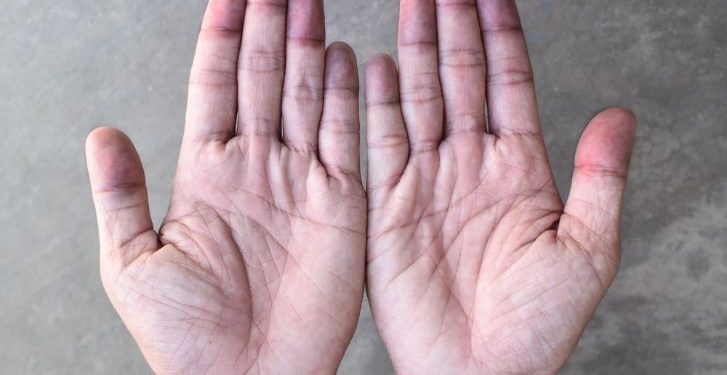If you notice a blue tint to your skin, lips or fingertips, see your doctor immediately. It could be a sign of a serious medical condition that needs urgent treatment.
Cyanosis is a bluish-gray or purplish tint to the skin and mucous membranes, which means there is less oxygen than usual in your blood. Normally, your blood has a pink or red color that indicates it is carrying enough oxygen throughout your body.
It travels from your lungs to the heart where it is pumped through arteries to your organs and tissues. Then, it returns to your heart and lungs through veins. It’s this return trip to the heart and lungs that causes your blood to become bluish.
A variety of conditions can cause cyanosis in different parts of your body. The specific cause will determine the treatment you need.
The first thing your doctor will do is perform a physical exam of your body to determine the underlying problem. Your doctor will also ask you about your medical history and when your symptoms started. They may also take a blood sample to check for certain conditions that can lead to cyanosis.
They’ll also listen to your heart and lungs with a stethoscope. They’ll look for signs of problems like abnormal heart sounds, a heart murmur and lung crackles.
When your doctor hears these, it will tell them if your cyanosis is caused by a heart or lung problem. The condition that is causing your cyanosis may require medication, surgery or other treatments.
Your doctor may also want to test your hemoglobin level and oxygen saturation in your blood. If the levels are too low, your cyanosis is likely to be caused by an underlying problem with your blood cells that doesn’t allow them to carry oxygen as they should.

If your cyanosis is caused by an abnormality in your hemoglobin, you should have a blood test called a hemoglobin electrophoresis. If the tests show your cyanosis is caused by your hemoglobin, you’ll need treatment for this.
Other conditions that can cause cyanosis include a lack of oxygen in your blood (hypoxia), and congenital or birth defects of the heart and lungs. If you’re diagnosed with these, you’ll need treatment to restore normal levels of oxygen in your blood and to improve circulation to the organs and tissues.
In most cases, your doctor will recommend lifestyle changes that can help you maintain healthy blood flow to your organs and tissues. These include exercising regularly, avoiding rapid changes in temperature and reducing stress.
The most common symptom of cyanosis is a bluish tint to the lips and fingers. You might also notice numbness or tingling in your arms and legs.
When your cyanosis is caused by poor oxygen supply to the brain, you might also notice dizziness or confusion. Your doctor may recommend medications, exercise or oxygen therapy to restore your oxygen supply and blood flow to the brain.
Your doctor might also consider surgery to repair an underlying heart or lung problem, such as a hole in the heart or an irregular valve in your lungs. Other treatments might include medication to control breathing problems or a drug that relaxes the blood vessels.









